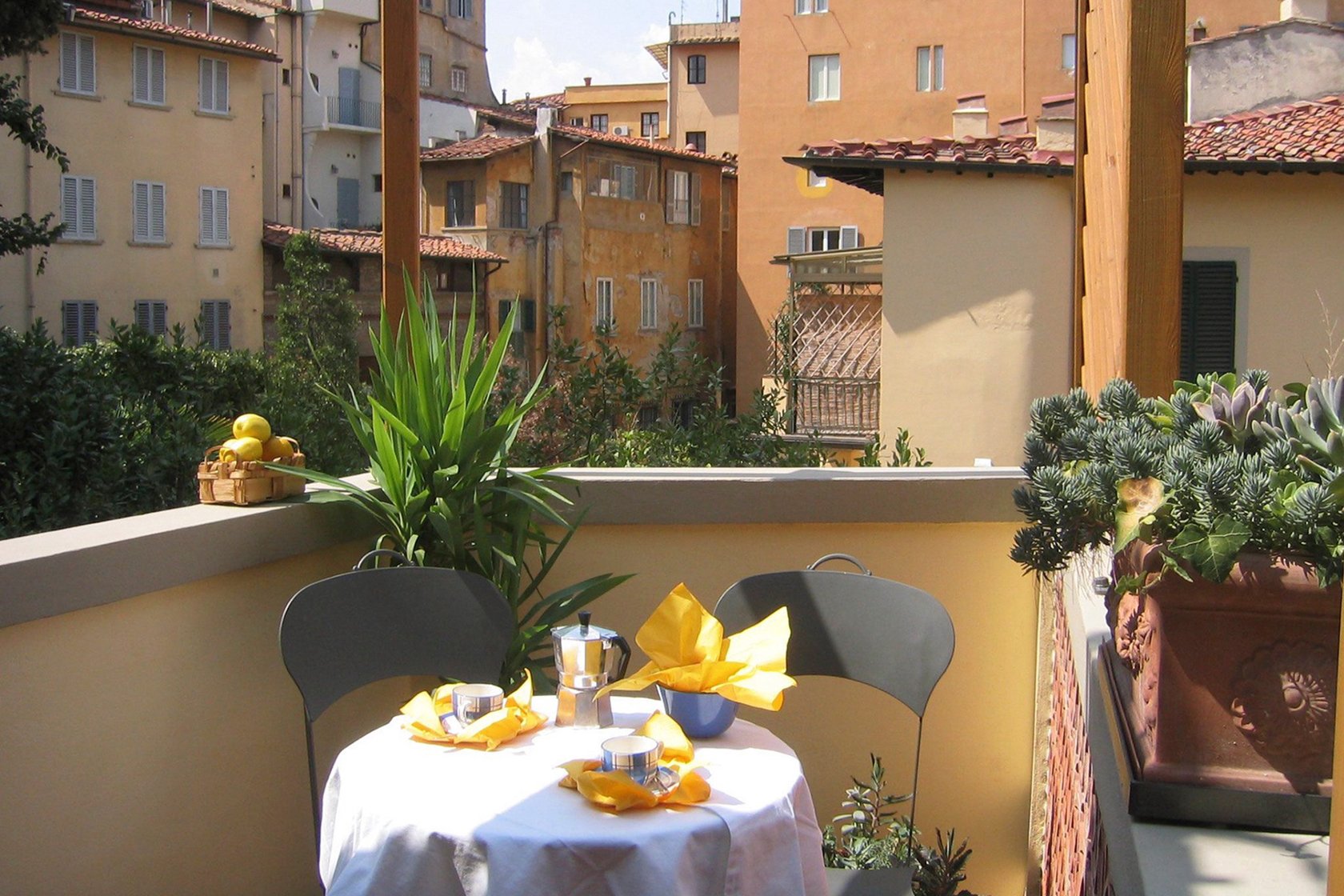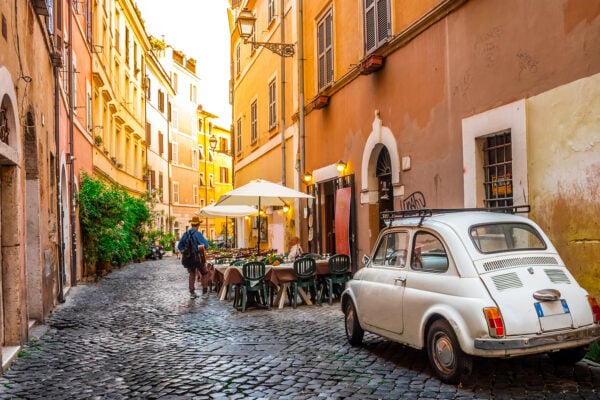
There’s no better way to see Florence than by walking through its charming streets, crossing over the Ponte Vecchio and spending time in piazzas surrounded by history. Its small size makes it ideal for exploring on foot, with an enviable list of sights right in the centro storico. Yet, if you enjoy a longer walk, there’s nothing quite like the feeling of looking out over Florence from one of its scenic viewpoints like the popular Piazzale Michelangelo or incredibly scenic Basilica of San Miniato al Monte. Here’s our self-guided Florence walking tour that will take you to one of the most beautiful overlooks in the city along with the highlights of what you can see and do along the way.
Panoramic Florence Views Walk
This walk will take you from the center of Florence, starting at the Ponte Vecchio bridge, up to the Basilica of San Miniato al Monte. The walk is about 2 miles round trip, but can be shortened by stopping at the Piazzale Michelangelo. Plan at least an hour of walking time, but you’ll want far more for stops at historic sights, exploring gardens and, of course, taking a lot of photos along the way.

Take your time to enjoy the views as you walk (credit)
Florence Walking Tour Route
From the center of Florence, head to the Ponte Vecchio and cross over to the Oltrarno side. With the bridge to your back, take a left under the arched passageway onto Via de’ Bardi. After a short walk the road opens on the left to a view back to Ponte Vecchio with the Uffizi Gallery just across the Arno. With your back to the river look for narrow road that splits away from the river – that’s Via de’ Bardi. Continue straight and along the way you’ll pass the entrance to the Villa Bardini Gardens at Via de’ Bardi 1. Shortly after, at Piazza dè Mozzi, you’ll find the entrance to the Museo Stefano Bardini on the left.
Just after the the museum, Via de’ Bardi becomes Via di San Niccolò. Continue straight and the road will lead you directly to Piazza Giuseppe Poggi and the Porta San Niccolò, which was once one of the Medieval access points to the city walls around Florence. From there, signs will indicate a pathway and steps in the direction of the Giardino delle Rose and the Piazzale Michelangelo. This is where you’ll start going uphill, zigzagging a bit and following the steps rather than the Viale Giuseppe Poggi – although some of the walk is along the road too. After a climb, you’ll reach the large Piazzale Michelango with a reproduction of Michelangelo’s David in the middle.

A view of San Miniato al Monte (credit)
To continue up to San Miniato al Monte, follow the signs along Viale Galileo (to the right if you’re standing with your back to the view and the statue of David) and after not too far you’ll see a grand double staircase on the left. Climb that to reach San Miniato to visit the basilica and for even more spectacular views over Florence.
On the way back down, you can meander through the Giardino delle Rose, a terraced garden, which is a lovely spot to rest during your walk. At the bottom, continue down Via del Monte alle Croci straight to Porta San Miniato, the arched entrance through the old stone walls of Florence. Just beyond is Via di San Niccolò, and if you take a left it leads back to the center of Florence and Ponte Vecchio.
Highlights Along the Way
Here’s a look at some of the spots you can stop to visit and explore on this walk, depending on your interests and time available. There’s plenty to discover!

Museo Stefano Bardini (credit)
Museo Stefano Bardini & Bardini Gardens
Florence is full of hidden gems and excellent small museums. The Museo Stefano Bardini is one of our favorites with its eclectic but beautiful collection of paintings, sculpture, ceramics and furniture, and so much more. It was the private collection of Stefano Bardini (1836-1922), an important Italian antiquarian, who created the museum and donated it to the city of Florence. See works by Donatello, Tintoretto, Tiepolo, and ceramics by the Della Robbia workshop.
Not far from the museum is the expansive Bardini Gardens, a beautiful Renaissance garden that was bought by Stefano Bardini in 1913. The garden has many treasures, including a particularly picturesque terraced garden that spills down the hillside with a long central staircase. Just a bit under 10 acres in size, these gardens are much smaller and easier to explore than the Boboli Gardens, but with absolutely lovely views. While nice anytime of the year, visit in the spring when the wisteria covered pergolas create an impossibly romantic view overlooking Florence. The Villa Bardini, located at the top of the gardens, is home to the Museo Pietro Annigoni, dedicated to an influential 20th-century Florentine painter. Find out more about the Bardini Gardens & Museum in Florence here.

Porta San Niccolò tower with a view up to Piazzale Michelangelo (credit)
Porta San Niccolò
While this watchtower stands out now in the middle of Piazza Giuseppe Poggi, it was once part of the defensive walls and one of the entrances to Florence. Built in 1324, it’s the only tower left that has kept its original height. The tower is open from the end of June to September and if you climb the 160 steps to the top you’ll find a nice view along the Arno. The tower is usually only open in the evenings, but visit the San Niccolò Tower website for the latest opening hours.

The view from Piazzale Michelangelo is well worth the walk! (credit)
Piazzale Michelangelo
The expansive Piazzale Michelangelo offers the most famous view overlooking Florence and has been a popular spot since it was created in 1869. The architect Giuseppe Poggi was tasked with redeveloping the hills on the southern side of the Arno in a grand urban renewal plan after Florence became the capital of Italy in 1865 – a title it would hold until the capital was moved to Rome in 1871. The square is named after the great Renaissance artist Michelangelo and features replicas of some of his important works around Florence. Most notable is the large bronze statue of David and works from the Medici Chapels in the Basilica of San Lorenzo.

The striking Romanesque facade of San Miniato al Monte. (credit)
San Miniato al Monte Basilica
In a city of remarkable churches, San Miniato al Monte stands out as one of the oldest Romanesque churches in Florence as well the most scenic – by far. Climb the grand staircase leading up the church, which is often a more tranquil viewpoint than Piazzale Michelangelo, with the added bonus of incredible art and history. While it may appear more modern, the facade—with its geometrical patterns in green and white marble—was started in 1090 and completed in the 12th century. Inside, there’s plenty to explore in the highly decorated nave, crypt, choir and presbytery, including intricate mosaics and inlaid floors from the 13th century and frescoes from the 14th century.
You can also visit the Cimitero delle Porte Sante, a monumental cemetery established in 1837 and planned by Niccolò Matas, who designed the facade of the Basilica of Santa Croce. Buried there is one very familiar name for many travelers: Carlo Collodi, the Italy writer who is famous as the creator of Pinocchio. There’s also a small monastic shop at San Miniato al Monte where you can find a selection of candles, natural products and sweets made by the Benedictine monks. For an incredible experience, visit the basilica in the evening when the Eucharist is celebrated in Latin with Gregorian chants (6pm daily and 5:30pm Sunday). Entrance to the church is free, but do check the schedule in advance as the church is closed to visitors during services.

Beautiful views from the Rose Garden. (credit)
Giardino delle Rose
For another pretty route back down to the center of Florence, or a detour from Piazzale Michelangelo, take a stroll through the Giardino delle Rose. This beautiful garden was part of Giuseppe Poggi’s design for Piazzale Michelangelo in 1865 and cascades down the hill with a meandering pathway. It includes over 400 varieties of roses, a Japanese garden and many other types of plants. Although especially lovely in May and June when the roses bloom, it is an appealing viewpoint year round. The garden is open every day from 9am to dusk and is free to visit.
Know Before You Go
Any day is a good day to enjoy this Florence walking tour with panoramic views from Piazzale Michelangelo and San Miniato al Monte. But if you’re planning to visit some of the suggested highlights along the way, keep in mind that the Museo Stefano Bardini is currently only open from Friday to Monday and the Bardini Gardens are closed on the first and last Mondays of every month. The Porta San Niccolò is open seasonally from June to September. Pack a pair of comfortable walking shoes and enjoy exploring Florence.
Alternative route: take the bus! You can enjoy the same beautiful views over Florence without the long walk by simply hopping on the bus. The 12 and 13 buses run frequently from the historic center and go to Piazzale Michelangelo.
Where to Stay

The Casetta Bonsi is a perfect home base in Florence.
Looking for a beautiful stay in Florence? With an ideal location near the Ponte Vecchio in the charming Oltrarno neighborhood, our lovely Maestro apartment is full of historic charm while the Casetta Bonsi is a jewel-box of a house with a terrace. View more of our Florence vacation rentals and contact our team for help finding your perfect stay in Florence!



